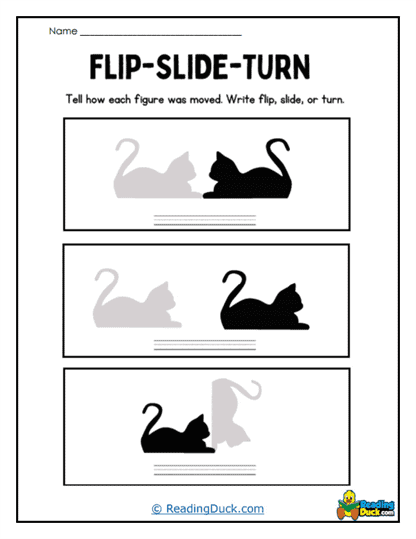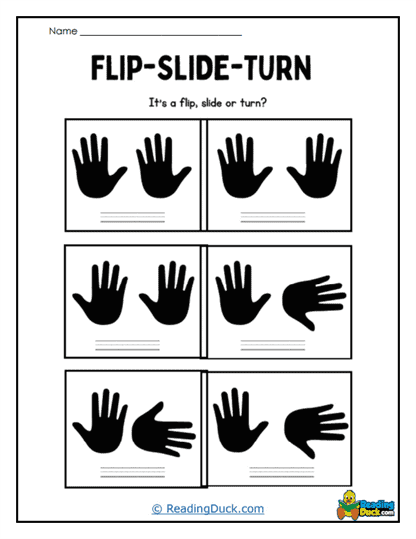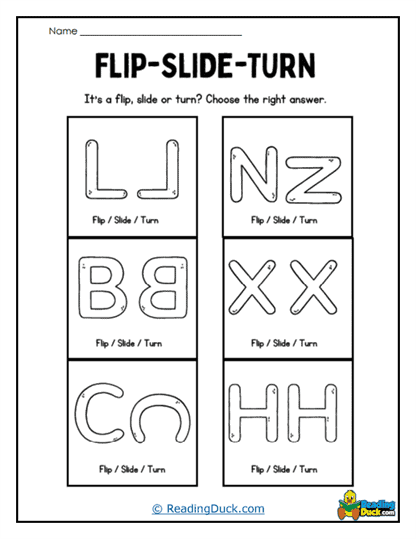Flip, Slide, and Turn Worksheets
About Our Flip, Slide, and Turn Worksheets
Our Flip, Slide, and Turn worksheets are designed to help students develop a thorough understanding of spatial relationships using position words. This collection falls under the Vocabulary category within the Skills section, specifically in the Position Words subcategory. These worksheets focus on teaching students how to describe the movements of objects using key terms like "flip," "slide," and "turn," which are essential for developing spatial awareness and geometric understanding.
Presented in a downloadable PDF format, the worksheets are easy to access, view, and print, allowing for immediate use in various educational settings. Each worksheet comes with an answer key, making it easy for educators and parents to assess student progress quickly and accurately. Whether used in the classroom, during homeschooling, or for independent practice, these worksheets offer a versatile and engaging approach to mastering the vocabulary of spatial movements.
Exploring Position Words: Flip, Slide, and Turn
Position words such as flip, slide, and turn describe how objects move or change orientation in space. These words are important not only in everyday conversation but also in geometry, where understanding spatial transformations is a foundational skill. Teaching these concepts helps students understand how objects can move in different ways and how their orientation or position changes as a result.
In a classroom setting, a teacher might explain these concepts with simple visual examples. For instance, "When you flip a paper, you turn it over so the other side is facing up. When you slide it, you move it across the table without lifting it. And when you turn it, you rotate it around a point or axis."
Examples of Position Words in Use:
- "If you flip the card over, you'll see the image on the back."
- "When you slide the book to the left, it stays flat on the table but moves sideways."
- "To turn the steering wheel, you rotate it left or right to change the car's direction."
These examples illustrate how students encounter these spatial transformations in everyday life. Our worksheets use diagrams and hands-on activities that invite students to practice identifying and describing flips, slides, and turns in various contexts. By providing multiple ways to interact with these concepts, the worksheets ensure students build a strong foundation in spatial reasoning.
Adapting to Different Learning Styles
Our Flip, Slide, and Turn worksheets are specifically designed to accommodate different learning styles, ensuring that all students can successfully engage with the material. Recognizing that students learn best when the material is presented in a variety of formats, we have incorporated visual, auditory, and kinesthetic learning opportunities into these worksheets.
Supporting Various Learning Preferences:
- Visual Learners: Clear diagrams and illustrations are provided to show examples of objects being flipped, slid, or turned. These visual cues help students see the transformations in action, making it easier to understand and identify them in the exercises.
- Auditory Learners: Teachers and parents can read the instructions aloud, or hold discussions about the concepts. For example, students can describe the movements they see in pictures, reinforcing the vocabulary by hearing and speaking the terms.
- Kinesthetic Learners: Hands-on activities, such as physically flipping, sliding, or turning objects, give students an opportunity to experience the concepts through movement. These activities can involve manipulating classroom objects or using cut-out shapes to mimic the transformations.
This comprehensive approach allows students to engage with the material in the way that best suits their individual learning styles. By catering to these varied preferences, we ensure that each student has the tools to grasp the concepts of flipping, sliding, and turning.
Flexibility Across Educational Settings
One of the key benefits of our Flip, Slide, and Turn worksheets is their versatility, making them suitable for a range of educational environments. Whether used in traditional classrooms, homeschooling, or as part of independent study programs, these worksheets can be easily adapted to fit the unique needs of each setting.
Ways to Use These Worksheets:
- Group Activities: In a classroom setting, teachers can incorporate the worksheets into group exercises where students collaborate to identify flips, slides, and turns in different objects. Group work encourages peer learning and fosters discussion, helping students articulate their understanding.
- Individual Assignments: These worksheets are also ideal for independent practice, allowing students to complete the tasks on their own. This helps reinforce learning at their own pace and gives them the opportunity to focus on areas where they need additional practice.
- Homeschooling: For parents homeschooling their children, these worksheets provide structured, easy-to-follow activities that align with educational standards. They can be incorporated into daily lessons or used for supplemental learning.
- Enrichment and Remediation: The worksheets can be used to challenge advanced students with more complex transformations or to provide extra practice for students who need additional support with spatial reasoning.
This flexibility makes the Flip, Slide, and Turn worksheets a valuable resource for any educational setting, ensuring that students can learn these concepts in a way that fits their learning environment.
Supporting Early Language and Spatial Development
The concepts of flipping, sliding, and turning are not only essential for geometric understanding but also play a significant role in early language and spatial development. For young learners, these worksheets are a valuable tool for building both communication skills and spatial awareness, helping them describe how objects move in space.
Benefits for Early Learners:
- Expanding Vocabulary: By learning and practicing words like "flip," "slide," and "turn," students expand their vocabulary and learn how to describe spatial movements accurately. This vocabulary development is crucial for effective communication in both academic and everyday contexts.
- Building Spatial Awareness: Understanding how objects move and change orientation helps young learners develop spatial reasoning, which is critical for problem-solving and logical thinking. The worksheets provide hands-on opportunities to practice these skills, improving students' ability to visualize and manipulate objects in their minds.
- Engaging and Interactive: The worksheets are designed to keep students engaged through interactive activities. Whether they are identifying movements in diagrams or physically manipulating objects to demonstrate a flip, slide, or turn, these activities encourage active participation and deeper learning.
By focusing on early language development and spatial reasoning, these worksheets provide a strong foundation for more advanced topics in both language and mathematics.
Enhancing Learning for English Language Learners (ELL)
Our Flip, Slide, and Turn worksheets are especially beneficial for English Language Learners (ELL), helping them master critical spatial vocabulary through clear visual examples and hands-on activities. These worksheets provide ELL students with practical tools to improve their language skills while also building their understanding of spatial transformations.
How These Worksheets Support ELL Students:
- Visual Representation: Each worksheet features simple, clear diagrams that visually demonstrate the concepts of flipping, sliding, and turning. This visual support is crucial for ELL students, allowing them to connect the vocabulary words with their meanings without relying solely on text.
- Simplified Language: The instructions are written in straightforward, accessible language, ensuring that ELL students can follow along and complete the activities with ease. By focusing on clear, concise explanations, the worksheets help ELL students improve their comprehension and vocabulary.
- Real-World Application: Through practical exercises, ELL students can practice using spatial vocabulary in context. These activities reinforce their understanding of how to describe movements in space, which is a skill they can apply in both academic settings and daily interactions.
By providing ELL students with accessible, engaging learning materials, these worksheets help bridge the gap between language acquisition and spatial reasoning, supporting their overall academic growth.
Educator Strategies for Teaching Flip, Slide, and Turn
To ensure that students master the concepts of flipping, sliding, and turning, educators can implement a variety of teaching strategies that reinforce these ideas and provide meaningful opportunities for practice.
Effective Strategies for Teaching Spatial Transformations:
- Use Real Objects: Start by demonstrating flips, slides, and turns with real objects in the classroom. For example, use a book to show how it can be flipped over, slid across the table, or turned around. This hands-on demonstration helps students visualize the movements.
- Incorporate Physical Activities: Have students physically engage with the concepts by arranging themselves or objects in different positions. For instance, students can take turns demonstrating a slide or turn using cut-out shapes or manipulatives.
- Integrate Technology: Use interactive tools such as digital whiteboards or educational apps to show animations of flips, slides, and turns. Students can participate by predicting how objects will move or by manipulating virtual objects themselves.
- Daily Vocabulary Practice: Integrate the terms "flip," "slide," and "turn" into daily classroom activities. For example, ask students to describe how they moved their chair or how they turned the page in a book. Consistent use of these words reinforces understanding and retention.
These strategies help educators create a dynamic, interactive learning environment where students can master spatial transformations and confidently use position words in their vocabulary.
Conclusion
Our Flip, Slide, and Turn worksheets are a versatile, engaging resource for teaching students essential spatial vocabulary. Designed to accommodate different learning styles and adaptable to various educational settings, these worksheets help students develop a clear understanding of how objects move and change orientation. Through interactive activities and hands-on learning, students gain valuable skills in spatial reasoning, language development, and geometric concepts.
Whether used in classrooms, homeschool settings, or independent study, these worksheets are an invaluable tool for helping students master flips, slides, and turns. They also offer targeted support for English Language Learners, providing clear visual examples and practical exercises that make learning accessible to all.









